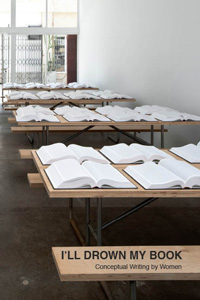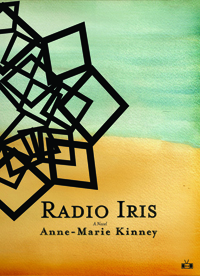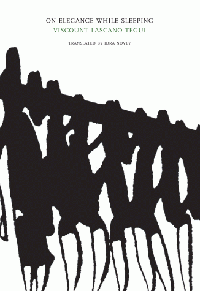 I’ll Drown My Book: Conceptual Writing by Women
I’ll Drown My Book: Conceptual Writing by Women
Edited by Caroline Bergvall, Laynie Browne, Teresa Carmody, & Vanessa Place
Les Figues Press, 2012
455 pages / $40 Buy from Les Figues Press
One half of a knucklebone or other object was a common object to carry in ancient Greece as an identifier to whoever carried the other half: a symbolon, the root of the word symbol. A symbol is a half-thing but of course most things are half-things; otherwise, what is language for? It fossilizes the potential of objects into meaning. Art has that to deal with. Language that knows it is art, on the other hand, seems to seek objecthood.
A walk through a regular art museum might have you thinking art is paintings. A distant second to that is sculpture, then drawings and prints, etc., and the farther the object deviates from these materials (or if the object was made for any other purpose than aesthetic contemplation, say, a quilt), not only is it less likely the object will be canonized (without any modifying category) as art, but the more the object will require mediation, textual padding between audience and object.
Perhaps what makes a work Conceptual, then, in visual art and in writing, is that as an object it attends to its physical deviation from canonical works but also shifts its weight to its context rather than its object. “A construction [is] a beginning of a thing,” wrote Yoko Ono in her Conceptual art book Grapefruit, and in this view, an object or a text is an idea’s anchor that begins, rather than completes, the idea.
The writings in I’ll Drown My Book are surrounded by frames: two introductions and one afterword by the editors. Each selection is then also followed by a writer’s statement, often a description of the work’s procedure or a response to the term Conceptual as it applies to her work. This textual-framing reminds me very much of how the visual arts are presented, propped by text panels in galleries and museums, battened by artist’s statements in magazines and catalogs. And ultimately, Conceptual writing itself is consciously framed by the Conceptual art movement of the 60s and its earlier predecessors in Dada and related movements; solidified by Duchamp in 1917 in his defense of his readymades which refused to supplement art objects with context but instead supplanted them with context. But Conceptual art, just as it is in writing now, never came to define a precise artistic practice, and because of this it became a convenient bag to throw anything that didn’t seem like art. In other words, art that was hard to sell: performances, happenings, instructions, installations, ephemera, sounds, silence. In dematerializing of the art object, artists were certainly responding to the hyper-commodification of contemporary art and its increasingly opaque economics.
READ MORE >

 How to Get Into the Twin Palms
How to Get Into the Twin Palms


 Objects for a Fog Death
Objects for a Fog Death On Elegance While Sleeping
On Elegance While Sleeping Light Without Heat
Light Without Heat